Related Research Articles

Harland & Wolff is a Northern Irish shipbuilding company based in Belfast, Northern Ireland. It specialises in ship repair, shipbuilding and offshore construction. Harland & Wolff is famous for having built the majority of the ocean liners for the White Star Line, including Olympic-class trio – RMS Olympic, RMS Titanic and HMHS Britannic. Outside of White Star Line, other ships that have been built include the Royal Navy's HMS Belfast; Royal Mail Line's Andes; Shaw, Savill & Albion's Southern Cross; Union-Castle's RMS Pendennis Castle; and P&O's Canberra. Harland and Wolff's official history, Shipbuilders to the World, was published in 1986.
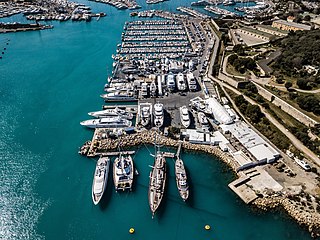
A shipyard, also called a dockyard or boatyard, is a place where ships are built and repaired. These can be yachts, military vessels, cruise liners or other cargo or passenger ships. Compared to shipyards, which are sometimes more involved with original construction, dockyards are sometimes more linked with maintenance and basing activities. The terms are routinely used interchangeably, in part because the evolution of dockyards and shipyards has often caused them to change or merge roles.

Vigor Shipyards is the current entity operating the former Todd Shipyards after its acquisition in 2011. Todd Shipyards was founded in 1916, which owned and operated shipyards on the West Coast of the United States, East Coast of the United States and the Gulf. Todd Shipyards were a major part of the Emergency Shipbuilding Program for World War II.
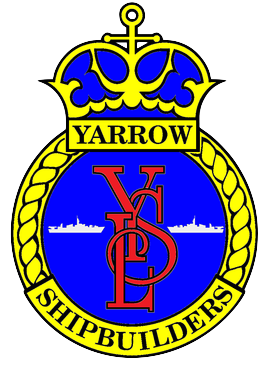
Yarrow Shipbuilders Limited (YSL), often styled as simply Yarrows, was a major shipbuilding firm based in the Scotstoun district of Glasgow on the River Clyde. It is now part of BAE Systems Surface Ships, owned by BAE Systems, which has also operated the nearby Govan shipyard since 1999.
Bathurst Street Wharf was a series of shipyards located in Toronto, Ontario, Canada, between Bathurst Street and Spadina Avenue along Lake Shore Boulevard West.
Toronto Drydock Company is a shipbuilding repair company in Canada and the name of two shipbuilders in the 19th and 20th centuries respectively.
Marine Industries Limited (MIL) was a Canadian ship building, hydro-electric and rail car manufacturing company, in Sorel-Tracy, Quebec, with a shipyard located on the Richelieu river about 1 km from the St. Lawrence River. It employed up to 8,500 people during the World War II support effort.
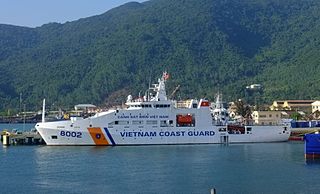
The Damen Group is a Dutch defence, shipbuilding, and engineering conglomerate company based in Gorinchem, Netherlands.
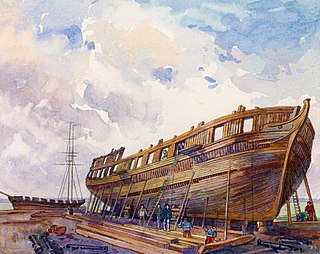
The Naval Shipyards were naval shipbuilding facilities used by the Provincial Marine and the Royal Navy in York, Upper Canada. The naval shipyards were ordered by the Lieutenant Governor of Upper Canada John Graves Simcoe in 1793, and were opened in 1798.
Smith's Dock Company, Limited, often referred to simply as Smith's Dock, was a British shipbuilding company.

The Blyth Shipbuilding & Dry Docks Company Ltd. was a British shipyard located in Blyth, Northumberland, England.
Canadian Vickers Limited was an aircraft and shipbuilding company that operated in Canada during the early part of the 20th century until 1944. A subsidiary of Vickers Limited, it built its own aircraft designs as well as others under licence. Canadair absorbed the Canadian Vickers aircraft operations in November 1944.

Burrard Dry Dock Ltd. was a Canadian shipbuilding company headquartered in North Vancouver, British Columbia. Together with the neighbouring North Van Ship Repair yard and the Yarrows Ltd. yard in Esquimalt, which were eventually absorbed, Burrard built over 450 ships, including many warships built and refitted for the Royal Navy and Royal Canadian Navy in the First and Second World Wars.

Davie Shipbuilding is a historic shipbuilding company located in Lauzon, Quebec, Canada. The facility is now operating as Chantier Davie Canada Inc. and is the oldest continually operating shipbuilder in North America.
Saint John Shipbuilding was a Canadian shipbuilding company located in Saint John, New Brunswick. The shipyard was active from 1923 to 2003.
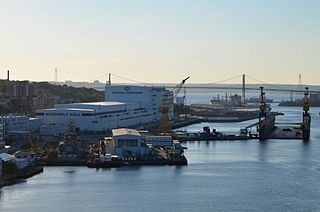
The Halifax Shipyard Limited is a Canadian shipbuilding company located in Halifax, Nova Scotia.
The Western Dry Dock and Shipbuilding Company was a shipyard that operated at Port Arthur, Ontario, now part of Thunder Bay, on Lake Superior from 1911 to 1993. The shipyard was established in 1909 and renamed in 1916 as the Port Arthur Shipbuilding Company. The yard closed in 1993. It reopened as a repair yard Lakehead Marine and Industrial, however that venture failed in 2014. As of 2016, the shipyard was purchased by Heddle Marine. It is operated by Heddle Marine in partnership with Fabmar Metals Inc, of Thunder Bay. The venture focuses on ship repair services and winter layup options.

General Engineering & Dry Dock Company was a shipbuilding and ship repair company in Alameda, California that was active from the 1920s through the 1940s. The company built ships for the Southern Pacific Railroad and the United States Coast Guard in the late 1920s and early 1930s and took part in the World War II shipbuilding boom, making diesel-propelled steel hulled auxiliaries for the United States Navy, primarily oceangoing minesweepers.
Kingston Shipyards was a Canadian shipbuilder and ship repair company that operated from 1910 to 1968. The facility was located on the Kingston waterfront property known as Mississauga Point, which is the now the site of the Marine Museum of the Great Lakes at Kingston.

Craig Shipbuilding was a shipbuilding company in Long Beach, California. To support the World War I demand for ships Craig Shipbuilding shipyard switched over to military construction and built: US Navy Submarines and Cargo Ships. Craig Shipbuilding was started in 1906 by John F. Craig. John F. Craig had worked in Toledo, Ohio with his father, John Craig (1838-1934), and Blythe Craig, both shipbuilders, their first ship was built in 1864 at Craig Shipbuilding Toledo. John F. Craig opened his shipbuilding company in Port of Long Beach on the south side of Channel 3, the current location of Pier 41 in the inner harbor, becoming the port's first shipyard. In 1908 Craig Shipbuilding was given the contract to finishing dredging of the Port of Long Beach inner harbor and to dredge the channel connecting it to the Pacific ocean. In 1917 Craig sold the shipyard to the short-lived California Shipbuilding Company. but then opened a new shipyard next to the one he just sold and called it the Long Beach Shipbuilding Company. The Long Beach Shipbuilding Company built cargo ships in 1918, 1919, and 1920 for the United States Shipping Board.
References
Footnotes
Sources
- Pritchard, James (2011). A Bridge of Ships: Canadian Shipbuilding During the Second World War. McGill-Queen's Press – MQUP. ISBN 0773538240.